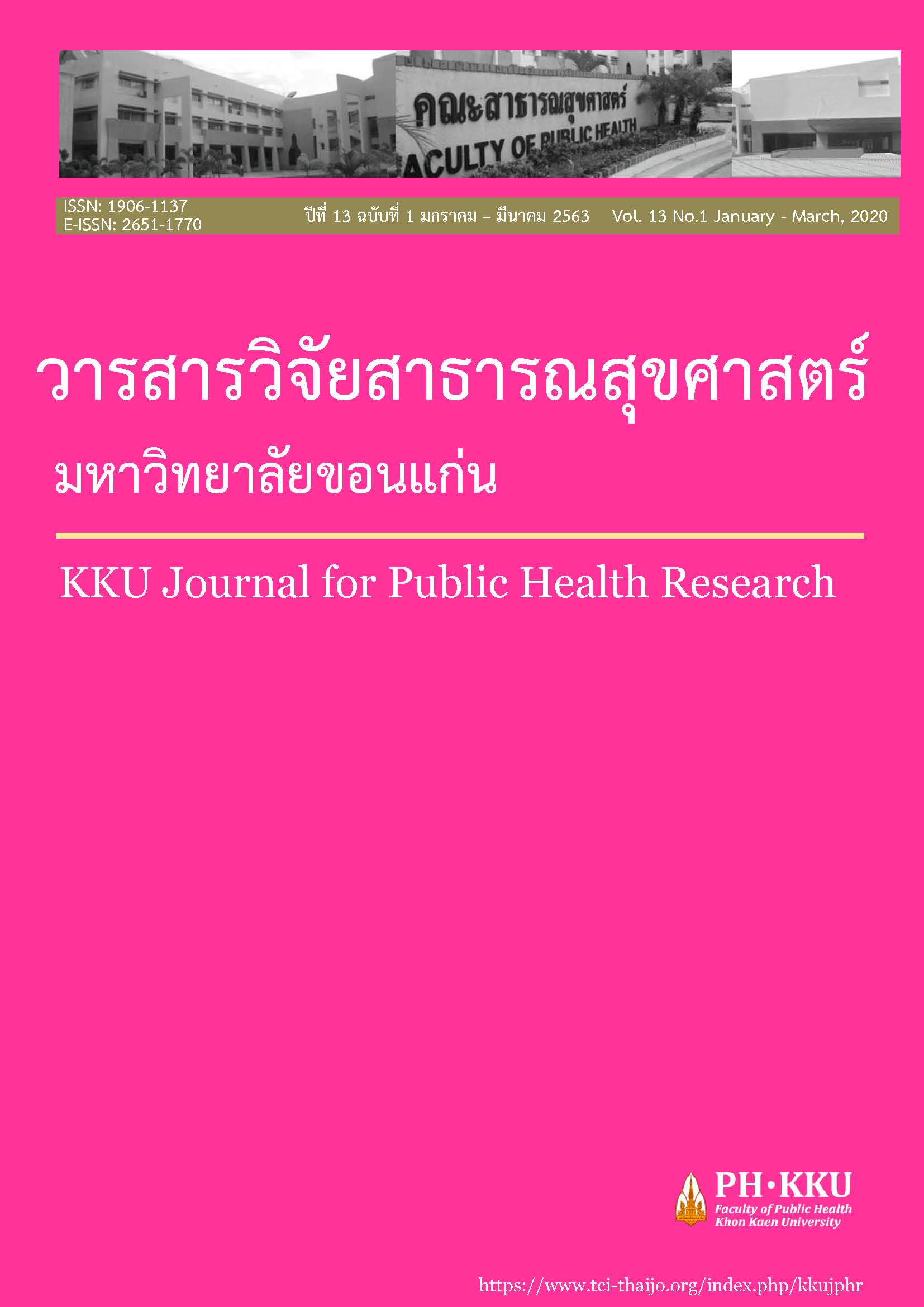การรับรู้ความกลมเกลียวในชุมชนกับการใช้สารเสพติดของผู้เข้าบำบัดยาเสพติดในภาคตะวันออกเฉียงเหนือ ประเทศไทย
คำสำคัญ:
การรับรู้ความกลมเกลียวในชุมชน, การใช้ยาเสพติด, ผู้เข้าบำบัดยาเสพติดบทคัดย่อ
การวิจัยแบบ Cross-sectional analytic study เพื่อศึกษาระดับการรับรู้ความกลมเกลียวในชุมชนและความสัมพันธ์ระหว่างการรับรู้ความกลมเกลียวในชุมชนกับการใช้สารเสพติด กลุ่มตัวอย่างคือผู้เข้าบำบัดยาเสพติด ณ ศูนย์บำบัดยาเสพติดแบบบังคับบำบัด ภาคตะวันออกเฉียงเหนือ ประเทศไทย จำนวน 336 คน เก็บรวบรวมข้อมูลโดยใช้แบบสัมภาษณ์และแบบวัดการรับรู้ความกลมเกลียวในชุมชน สถิติที่ใช้ได้แก่ ร้อยละ ค่าเฉลี่ย ส่วนเบี่ยงเบนมาตรฐาน และ Multinomial logistic regression ผลการวิจัย พบว่า เป็นเพศชาย (ร้อยละ 87.2) มีอายุเฉลี่ย 27.7 ปี จบการศึกษาระดับมัธยมศึกษาขึ้นไป (ร้อยละ 51.2) ว่างงาน (ร้อยละ 22.0) และมีประวัติเกี่ยวข้องกับยาเสพติด (ร้อยละ 68.8) มีคนในครอบครัวและเพื่อนใช้ยาเสพติด (ร้อยละ 41.1และ 69.3 ตามลำดับ) ส่วนใหญ่เสพยาบ้าอย่างเดียว (44.9%) และมีการรับรู้ความกลมเกลียวในชุมชนในระดับสูง (ร้อยละ 35.4) และจากการวิเคราะห์ความสัมพันธ์ระหว่างการรับรู้ความกลมเกลียวในชุมชนกับการใช้ยาเสพติด เมื่อควบคุมตัวแปรกวน พบว่า การรับรู้ความกลมเกลียวในชุมชนระดับสูง (AOR=0.37, 95% CI: 0.18, 0.77) และระดับปานกลาง (AOR=0.48, 95% CI: 0.23, 0.98) มีความสัมพันธ์กับการลดลงของการเสพยาบ้าอย่างเดียวอย่างมีนัยสำคัญทางสถิติ สรุปผลการศึกษา จะเห็นได้ว่าการรับรู้ความกลมเกลียวในชุมชนมีความสัมพันธ์กับการลดลงของการเสพยาบ้า ดังนั้นการส่งเสริมความกลมเกลียว ความไว้วางใจ ช่วยเหลือซึ่งกันและกันในชุมชนจึงเป็นสิ่งจำเป็นในการกำหนดมาตรการหรือพัฒนาสิ่งแทรกแซงในการป้องกันและลดการใช้สารเสพติด
เอกสารอ้างอิง
กนกพรรณ กัลยาณสุต, อนันต์ สุรพัฒน์, & จิราพร แก้วศรีงาม. (2553). รายงานวิจัยเรื่องการประเมินผลสัมฤทธิ์การแก้ไขฟื้นฟูผู้กระทำผิดในชุมชน ประจำปีงบประมาณ พ.ศ. 2553. กรุงเทพฯ: กรมคุมประพฤติ กระทรวงยุติธรรม.
กรมคุมประพฤติ กระทรวงยุติธรรม. (2558). สถิติคดีฟื้นฟูสมรรถภาพผู้ติดยาเสพติด. ค้นเมื่อ 10 มกราคม 2558,จาก http://164.115.41.115/doc_dop/file/categories2/20180110023613-0026101014.pdf
กาญจนา คุณารักษ์. (2555). การพัฒนารูปแบบการป้องกันการกระทำผิดซ้ำเกี่ยวกับยาเสพติด: กรณีศึกษา สถานพินิจและคุ้มครองเด็กและเยาวชน. วิทยานิพนธ์ปริญญาปรัชญาดุษฎีบัณฑิต สาขาวิชาพัฒนาศึกษา บัณฑิตวิทยาลัย มหาวิทยาลัยศิลปากร.
กิ่งกาญจน์ จงสุขไกล. (2556). การกระทำความผิดซ้ำเกี่ยวกับยาเสพติดในกลุ่มเด็กและเยาวชนในสถานพินิจและคุ้มครองเด็กและเยาวชนและศูนย์ฝึกและอบรมเด็กและเยาชนในพื้นที่ภาคตะวันออก. กรุงเทพฯ: กลุ่มวิจัยเด็ก เยาวชนและสิ่งเสพติด สถาบันวิจัยสังคม จุฬาลงกรณ์มหาวิทยาลัย.
ภูดิท เทพละออ. (2553). การกระทำความผิดกำหมายยาเสพติดให้โทษของผู้ต้องขังหญิงในทัณฑสถานหญิงพิษณุโลก. สารนิพนธ์ปริญญาศิลปศาสตรมหาบัณฑิต สาขาวิชาพัฒนาสังคม บัณฑิตวิทยาลัย มหาวิทยาลัยนเรศวร.
มานิตย์ มณีนิตย์. (2543). ปัจจัยทางสังคมกับการกระทำผิดคดียาเสพติดของผู้ต้องขังหญิง. วิทยานิพนธ์ปริญญาศิลปศาสตร มหาบัณฑิต สาขาวิชาสังคมวิทยาประยุกต์ บัณฑิตวิทยาลัย มหาวิทยาลัยเกษตรศาสตร์.
สำนักงานคณะกรรมการป้องกันและปราบปรามยาเสพติด. (2557). สถานการณ์ปัญหายาเสพติดปีงบประมาณ 2557 และแนวโน้มของปัญหา. ค้นเมื่อ 25 มีนาคม 2558, จาก http://goo.gl/FfL7W9
สำนักบริหารการสาธารณสุข. (2559). ระบบรายงานระบบติดตามและเฝ้าระวังปัญหายาเสพติด. ค้นเมื่อ 23 มีนาคม 2560, จาก https://is.gd/8069ro
อรรถชนะ บูรณธร. (2549). การติดคุกซ้ำของผู้ต้องขังคดียาเสพติด: ศึกษากรณีเรือนจำจังหวัดภาคใต้. วิทยานิพนธ์ปริญญาศิลปศาสตรมหาบัณฑิต สาขาวิชายุทธศาสตร์การพัฒนา บัณฑิตวิทยาลัย มหาวิทยาลัยราชภัฏภูเก็ต.
ASEAN Narcotics Cooperation Center. (2015). Asean drug monitoring report 2015. Retrieved November 23, 2016, from https://is.gd/5hJPuw
Buckner, J. C. (1988). The development of an instrument to measure neighborhood cohesion. American Journal of Community Psychology, 16(6), 771–791.
Byrnes, H. F., Miller, B. A., Chamratrithirong, A., Rhucharoenpornpanich, O., Cupp, P. K., Atwood, K. A., et al. (2013). The roles of perceived neighborhood disorganization, social cohesion, and social control in urban Thai adolescents’ substance use and delinquency. Youth & Society, 45(3), 404–427.
Crum, R. M., Lillie-Blanton, M., & Anthony, J. C. (1996). Neighborhood environment and opportunity to use cocaine and other drugs in late childhood and early adolescence. Drug and Alcohol Dependence, 43(3), 155–161.
Csete, J., Kaplan, K., Hayashi, K., Fairbairn, N., Suwannawong, P., Zhang, R., et al. (2011). Compulsory drug detention center experiences among a community-based sample of injection drug users in Bangkok, Thailand. BMC International Health and Human Rights, 11, 1-12.
De Haan, L., Boljevac, T., & Schaefer, K. (2009). Rural community characteristics, economic hardship, and peer and parental influences in early adolescent alcohol use. The Journal of Early Adolescence, 30(5), 629–650.
Duncan, S. C., Duncan, T. E., & Strycker, L. A. (2002). A multilevel analysis of neighborhood context and youth alcohol and drug problems. Prevention Science, 3(2), 125–133.
Embry, D., Hankins, M., Biglan, A., & Boles, S. (2009). Behavioral and social correlates of methamphetamine use in a population-based sample of early and later adolescents. Addictive Behaviors, 34(4), 343–351.
Galea, S., Nandi, A., & Vlahov, D. (2004). The social epidemiology of substance use. Epidemiologic Reviews, 26, 36–52.
Kamarulzaman, A., & McBrayer, J. L. (2015). Compulsory drug detention centers in East and Southeast Asia. The International Journal on Drug Policy, 26(Suppl 1), S33-37.
Kasiulevičius, V., Šapoka, V., & Filipavičiute, R. (2006). Sample size calculation in epidemiological studies. Gerontologija, 7(4), 225–231.
Lin, E. Y., Witten, K., Casswell, S., & You, R. Q. (2012). Neighbourhood matters: perceptions of neighbourhood cohesiveness and associations with alcohol, cannabis and tobacco use. Drug and Alcohol Review, 31(4), 402–412.
Mennis, J., Stahler, G. J., & Mason, M. J. (2016). Risky substance use environments and addiction: A new frontier for environmental justice research. International Journal of Environmental Research and Public Health, 13(6), 607.
Office of the Narcotics Control Board [ONCB]. (2015). Drug abuse prevention and solving action plan in 2015-2019. Retrieved December 1, 2015, from https://is.gd/PMCFtu
Patterson, J. M., Eberly, L. E., Ding, Y., & Hargreaves, M. (2004). Associations of smoking prevalence with individual and area level social cohesion. Journal of Epidemiology and Community Health, 58(8), 692–697.
Rodriguez, N., Katz, C., Webb, V. J., & Schaefer, D. R. (2005). Examining the impact of individual, community, and market factors on methamphetamine use: A tale of two cities. Journal of Drug Issues, 35(4), 665–693.
Sampson, R. J., Raudenbush, S. W., & Earls, F. (1997). Neighborhoods and violent crime: A multilevel study of collective efficacy. Science, 277(5328), 918–924.
Shareck, M., & Ellaway, A. (2011). Neighbourhood crime and smoking: the role of objective and perceived crime measures. BMC Public Health, 11, 930.
Theall, K. P., Sterk, C. E., & Elifson, K. W. (2009). Perceived neighborhood fear and drug use among young adults. American Journal of Health Behavior, 33(4), 353–365.
Thomson, N. (2010). Detention as treatment: Detention of methamphetamine users in Cambodia, Laos, and Thailand. Retrieved December 30, 2017, from https://is.gd/AQapVb
Tucker, J. S., Pollard, M. S., de la Haye, K., Kennedy, D. P., & Green, H. D. (2013). Neighborhood characteristics and the initiation of marijuana use and binge drinking. Drug and Alcohol Dependence, 128(1–2), 83–89.
United Nations Office on Drugs and Crime [UNODC]. (2015). World Drug Report 2015. Retrieved November 23, 2016, from https://www.unodc.org/wdr2015/
United Nations Office on Drugs and Crime [UNODC]. (2017). World Drug Report 2017. Retrieved March 23, 2018, from https://www.unodc.org/wdr2017/index.html
Werb, D., Kamarulzaman, A., Meacham, M. C., Rafful, C., Fischer, B., Strathdee, S. A., et al. (2016). The effectiveness of compulsory drug treatment: A systematic review. The International Journal on Drug Policy, 28, 1–9.
Wild, T. C., Roberts, A. B., & Cooper, E. L. (2002). Compulsory substance abuse treatment: An overview of recent findings and issues. European Addiction Research, 8(2), 84–93.



